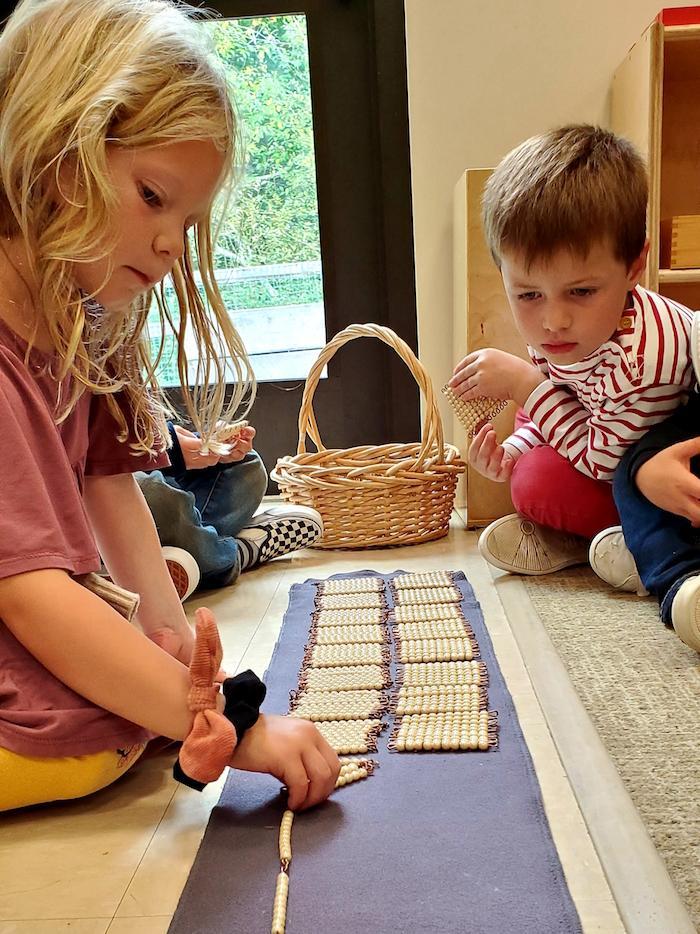The final year of Primary, often referred to as the kindergarten year, is a very special year. Having spent two or three years in the environment, these children are now the leaders of the room. It is easy to identify the kindergarten children, as they are ones working most independently with the greatest concentration. They are also the ones refining their leadership abilities by helping the other children. They are like little assistants to the teacher, and it is a joy to watch them.
The final year of Primary is so important that we strongly discourage parents from moving on to a conventional kindergarten. This is what we ask our parents to consider.
The Role of the Kindergarten Year
Maria Montessori designed the Primary program as a three-year cycle. Children ages 3 – 6 years old stay with the same teacher, in the same classroom. This third year becomes a pivotal time when all of the experiences of the previous years reach fruition, and a child’s deeper knowledge begins to fall into place. Students are guided to take on more complex work with an increased set of expectations and privileges in the classroom while experiencing rapid academic and social growth. Their time management skills are starting to develop and they continue to hone their ability to concentrate.

Learning At Their Pace
The 3-year cycle allows the child to acquire skills and academic knowledge at his own pace. Perhaps reading came more quickly than math, or fine-motor skills seemed second nature while gross-motor skills took longer. The Montessori Early Childhood environment has no set timetable for mastery but instead offers 3 full years to acquire capability. Not all 5½-year-olds are expected to be fluent readers or understand multiplication. Would you be comfortable being held accountable for a skill simply because a statistical model or a test stated you “should know this by now”?
The Child Becomes the Leader
Having children of different ages in the same room develops leadership and responsibility and unconsciously, your child has been eager to become one of the “big kids” in the classroom. Older children are encouraged to show their work to the new, younger students to aid their learning and become leaders in the process. This year of leadership gives a child immeasurable self-esteem and intellectual confidence as students continually reinforce their academic skills through helping other children, a well-documented way to consolidate knowledge. Where else can a 5 or 6 year old truly act as a leader and role model?

The Role of the Teacher
A key advantage of staying through the cycle is the depth of knowledge your teacher has amassed regarding your child. No time is lost at the beginning of the year trying to assess him/her. Third year students are ready to explode into more complex learning and discovery and they delve into a wealth of new and interesting materials with their trusted guide.
What Happens When Children Move
Children enter a conventional kindergarten classroom with a variety of experiences. Some have been in a day care setting, others have never been away from home, and others have been in preschool. The teachers will spend the first months of the year settling the children into a routine, getting to know who they are and assessing what they know. Your child has been in a Montessori environment for at least two years and is known by her teacher. He has been able to choose his own work and bring it to completion at his own pace. Your child has already been introduced to the foundations of language and math and they will be unable to complete the work to increase and solidify that knowledge. We know from speaking to parents who moved to conventional kindgarten that their children are often frustrated and bored as their work is no longer purposeful.
The jump from kindergarten to first grade is substantial for all children regardless of where they start. Why not let your child complete the cycle, experience the explosion of learning and be better prepared for the transition to first grade?
As you plan for your child’s future schooling we encourage you to view a video from American Montessori Society. We hope this video will provide more information about the benefits of having your child stay in a Montessori classroom for his or her pivotal kindergarten year.

The jump from kindergarten to first grade is substantial for all children regardless of where they start. Why not let your child complete the cycle, experience the explosion of learning and be better prepared for the transition to first grade?
As you plan for your child’s future schooling we encourage you to view a video from American Montessori Society. We hope this video will provide more information about the benefits of having your child stay in a Montessori classroom for his or her pivotal kindergarten year.
